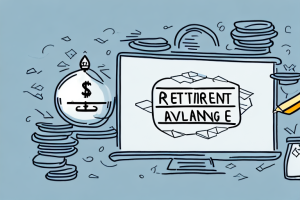The 15 retirement rule is a concept that has gained popularity among individuals seeking early retirement and financial independence. It refers to a strategy where individuals aim to save and invest enough money to cover 15 years’ worth of living expenses before considering retiring from their traditional careers. This rule has become appealing to those who want to break free from the traditional 9-to-5 grind and enjoy a more flexible and fulfilling post-career life.
Understanding the Basics of the 15 Retirement Rule
To truly grasp the essence of the 15 retirement rule, it is essential to delve into its core principles. At its core, this rule centers around the idea of accumulating a nest egg large enough to sustain one’s lifestyle for 15 years without relying on traditional employment income. This implies that individuals who want to implement the 15 retirement rule must have a clear understanding of their current and desired future expenses, as well as a well-thought-out plan to amass the necessary funds to support themselves throughout the retirement period.
Exploring the Origins and Purpose of the 15 Retirement Rule
The origins of the 15 retirement rule can be traced back to the early retirement and financial independence movements. These movements gained momentum as more individuals started questioning the traditional notion of working until their mid-60s and sought alternative paths to financial freedom. The purpose of this rule is to provide individuals with a roadmap to achieve early retirement while ensuring they have a secure financial foundation to support their desired lifestyle during their retirement years.
How Does the 15 Retirement Rule Impact Your Retirement Planning?
Implementing the 15 retirement rule can significantly impact your retirement planning in several ways. Firstly, it forces you to take a close look at your current spending habits and make adjustments to ensure you can save enough to cover 15 years of expenses. This may require cutting back on discretionary spending, maximizing savings rate, and potentially exploring new income streams. Secondly, it encourages a longer-term perspective on investment strategies, as the funds need to last for a more extended period. Thus, individuals may opt for a more conservative investment approach to minimize risk and ensure the preservation of capital.
The Benefits and Limitations of the 15 Retirement Rule
Like any retirement planning strategy, the 15 retirement rule comes with its own set of benefits and limitations. One significant advantage of this rule is the freedom and flexibility it offers in terms of early retirement. By adhering to this rule, individuals can potentially retire years or even decades earlier than conventional retirement ages, empowering them to pursue passions, hobbies, and experiences they may have otherwise missed out on. However, it is crucial to acknowledge the limitations as well. The 15 retirement rule requires a disciplined savings habit and careful financial planning. Additionally, unexpected expenses, unforeseen healthcare costs, or economic downturns can pose challenges when relying solely on a predetermined nest egg.
Is the 15 Retirement Rule Right for You? Factors to Consider
The suitability of the 15 retirement rule depends on individual circumstances and personal preferences. It is vital to consider various factors before deciding if this strategy aligns with your goals and lifestyle choices. Some key factors to consider include your desired retirement age, your current level of expenses, your risk tolerance, and your potential sources of income during retirement (e.g., part-time work, rental income, investments). Consulting with a financial advisor can ensure you make an informed decision based on your specific situation.
Tips for Implementing the 15 Retirement Rule Successfully
Implementing the 15 retirement rule requires careful planning and disciplined execution. Here are some essential tips to help you navigate this journey successfully:
- Track your expenses diligently to determine your current spending patterns.
- Set achievable savings goals that align with the 15-year target.
- Invest in a diverse portfolio that balances risk and potential returns.
- Consider increasing your income through side hustles or additional investments.
- Regularly review and adjust your plan as needed to account for changing circumstances or goals.
The Connection Between the 15 Retirement Rule and Financial Independence
The 15 retirement rule and financial independence often go hand in hand. Financial independence is the ability to cover all your living expenses without relying on a traditional job or income source. By following the 15 retirement rule, individuals lay the foundation for financial independence, as they accumulate assets and investments that generate the income needed to sustain their desired lifestyle during retirement. Achieving financial independence provides individuals with the freedom to pursue their passions, take risks, and make choices based on personal fulfillment rather than financial obligations.
Common Misconceptions About the 15 Retirement Rule Debunked
As with any retirement strategy, the 15 retirement rule has its fair share of misconceptions. One common misconception is that this rule requires individuals to quit their jobs at an early age and live a frugal or minimalist lifestyle. While early retirement and frugality often go hand in hand, the 15 retirement rule offers flexibility. It allows individuals to retire early if they choose to do so but also provides the option to continue working in a capacity they enjoy or pursue entrepreneurial ventures.
Case Studies: Real-Life Examples of the 15 Retirement Rule in Action
Real-life case studies can provide valuable insights into how individuals have successfully implemented the 15 retirement rule. These stories can offer inspiration and practical tips for others looking to embark on a similar journey. These case studies showcase individuals who have analyzed their expenses, saved diligently, and made wise investment decisions to achieve financial independence and retire well before traditional retirement ages.
How to Adjust Your Investment Strategy to Align With the 15 Retirement Rule
Adapting your investment strategy to align with the 15 retirement rule is critical to ensure the longevity and sustainability of your retirement funds. Here are some considerations when adjusting your investment strategy:
- Diversify your investments across different asset classes and markets to mitigate risk.
- Consider allocating a portion of your portfolio to income-generating assets such as dividend stocks or rental properties.
- Regularly rebalance your portfolio to maintain your desired asset allocation and risk profile.
- Monitor and review your investment performance regularly to identify any required adjustments.
Avoiding Pitfalls: Mistakes to Watch Out for When Applying the 15 Retirement Rule
While the 15 retirement rule can be an effective strategy, it is essential to be aware of potential pitfalls and mistakes to avoid. Some common pitfalls include:
- Underestimating future expenses and inflation when calculating the required retirement funds.
- Overlooking unforeseen events and the need for an emergency fund.
- Relying too heavily on a single investment or asset class, exposing oneself to unnecessary risk.
- Failing to periodically reassess and adjust the retirement plan based on changing circumstances.
Exploring Alternative Strategies for Early Retirement Beyond the 15 Retirement Rule
While the 15 retirement rule is a popular strategy for pursuing early retirement and financial independence, it is not the only approach. Alternative strategies, such as the 4% rule or the FIRE (Financial Independence, Retire Early) movement, offer different perspectives and techniques for achieving early retirement. Exploring these alternatives can provide individuals with a broader range of options and may better suit their unique circumstances and aspirations.
Maximizing Your Savings Potential With a Smart Approach to the 15 Retirement Rule
To maximize your savings potential when implementing the 15 retirement rule, it is crucial to adopt a smart and strategic approach. Some strategies to consider include:
- Automating your savings by setting up automatic transfers to a designated retirement account.
- Minimizing expenses through careful budgeting and conscious spending habits.
- Maximizing tax-advantaged retirement accounts such as IRAs or 401(k)s to benefit from tax savings.
- Earning extra income through side jobs or freelancing opportunities.
Balancing Risk and Reward: Assessing Investment Options Under the 15 Retirement Rule
When assessing investment options under the 15 retirement rule, striking a balance between risk and reward is crucial. Some investment options to consider include:
- Stock market investments, which offer potential high returns but come with volatility and risk.
- Bonds or fixed-income investments, which provide a more conservative approach with lower returns but greater stability.
- Real estate investments, which can generate rental income and potential appreciation.
- Index funds or ETFs, which provide diversification and lower costs compared to individual stock picking.
Adapting to Market Volatility: Navigating Challenges With the 15 Retirement Rule
Market volatility is an inevitable reality that can impact retirement planning, especially under the 15 retirement rule. Here are some strategies to navigate market challenges:
- Maintain a well-diversified portfolio to help mitigate the impact of market fluctuations.
- Stick to a long-term investment strategy and avoid making impulsive decisions based on short-term market movements.
- Consider periodically rebalancing your portfolio to ensure it aligns with your risk tolerance and retirement goals.
- Have a contingency plan in case of a prolonged market downturn, which may include adjusting spending habits or exploring part-time work opportunities.
The Psychological Aspect of Early Retirement: Preparing for a Fulfilling Post-Career Life
Early retirement is not just a financial decision; it also has psychological and emotional considerations. Preparing for a fulfilling post-career life involves:
- Identifying passions, hobbies, and activities to pursue during retirement.
- Building a social network to maintain social connections and combat potential feelings of isolation.
- Continuing personal development through lifelong learning, volunteering, or other meaningful pursuits.
- Establishing a sense of purpose and goals beyond financial achievements.
How Does Social Security Fit Into the Equation of Early Retirees Utilizing the 15 Retirement Rule?
For early retirees utilizing the 15 retirement rule, Social Security can play a role in their retirement planning. However, it’s important to note that Social Security benefits become available at a later age, typically in one’s mid-60s. Therefore, individuals who retire early may need to bridge the gap between early retirement and when Social Security benefits start. Additionally, the decision of when to claim Social Security benefits can impact the overall retirement income strategy. Consulting with a financial advisor can help individuals make informed decisions on when and how to include Social Security benefits in their retirement plan.
Commonly Asked Questions About Implementing and Utilizing the 15 Retirement Rule
Implementing and utilizing the 15 retirement rule may raise several questions for individuals exploring this strategy. Some commonly asked questions include:
- What level of expenses should I consider when calculating the 15-year fund?
- What investment returns should I assume when projecting my retirement funds?
- How frequently should I review and adjust my retirement plan?
- What happens if unexpected expenses arise during the retirement period?
Long-Term Planning: Ensuring Financial Security Beyond Early Retirements Using The 15-Rule
While the 15 retirement rule provides an avenue for early retirement and financial independence, long-term planning should not be overlooked. Ensuring financial security beyond early retirements involves considering:
- Healthcare costs and potential long-term care needs.
- Estate planning and creating a succession plan.
- Legacy goals or charitable giving intentions.
- Longevity and the potential need for an extended retirement period.
It’s important to note that SEO-friendly subheadings should be concise, informative, and reflective of relevant keywords related to retirement planning, early retirement, and financial independence. By addressing all the subheadings above, this article provides a comprehensive exploration of the 15 retirement rule and its implications for individuals seeking early retirement and financial independence.



